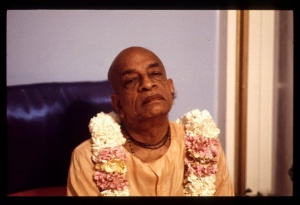SB 11.17.15: Difference between revisions
m (1 revision(s)) |
No edit summary |
||
| Line 1: | Line 1: | ||
{{info | {{info | ||
|speaker=Lord | |speaker=Lord Kṛṣṇa the Supreme Personality of Godhead | ||
|listener=Uddhava | |listener=Uddhava | ||
}} | }} | ||
[[Category:Srimad-Bhagavatam - Canto 11 Chapter 17]] | |||
[[Category:Bhagavatam Verses Spoken by Lord Krsna - Vanisource|111715]] | |||
<div style="float:left">'''[[Srimad-Bhagavatam]] - [[SB 11|Eleventh Canto]] - [[SB 11.17: Lord Krsna's Description of the Varnasrama System|Chapter 17: Lord Kṛṣṇa's Description of the Varṇāśrama System]]'''</div> | |||
<div style="float:right">[[File:Go-previous.png|link=SB 11.17.14]] '''[[SB 11.17.14]] - [[SB 11.17.16]]''' [[File:Go-next.png|link=SB 11.17.16]]</div> | |||
{{RandomImage}} | |||
{{SBnotice}} | |||
==== TEXT 15 ==== | ==== TEXT 15 ==== | ||
<div | <div class="verse"> | ||
varṇānām āśramāṇāṁ ca | :varṇānām āśramāṇāṁ ca | ||
janma-bhūmy-anusāriṇīḥ | :janma-bhūmy-anusāriṇīḥ | ||
āsan prakṛtayo nṟnāṁ | :āsan prakṛtayo nṟnāṁ | ||
nīcair nīcottamottamāḥ | :nīcair nīcottamottamāḥ | ||
</div> | </div> | ||
| Line 17: | Line 22: | ||
==== SYNONYMS ==== | ==== SYNONYMS ==== | ||
<div | <div class="synonyms"> | ||
varṇānām—of the occupational divisions; āśramāṇām—of the social divisions; ca—also; janma—of birth; bhūmi—the situation; anusāriṇīḥ—according to; āsan—appeared; prakṛtayaḥ—the natures; nṟṇām—of human beings; nīcaiḥ—by inferior background; nīca—inferior nature; uttama—by superior background; uttamāḥ—superior natures. | varṇānām—of the occupational divisions; āśramāṇām—of the social divisions; ca—also; janma—of birth; bhūmi—the situation; anusāriṇīḥ—according to; āsan—appeared; prakṛtayaḥ—the natures; nṟṇām—of human beings; nīcaiḥ—by inferior background; nīca—inferior nature; uttama—by superior background; uttamāḥ—superior natures. | ||
</div> | </div> | ||
{{SBcollapse}} | |||
==== TRANSLATION ==== | ==== TRANSLATION ==== | ||
<div | <div class="translation"> | ||
The various occupational and social divisions of human society appeared according to inferior and superior natures manifest in the situation of the individual's birth. | The various occupational and social divisions of human society appeared according to inferior and superior natures manifest in the situation of the individual's birth. | ||
</div> | </div> | ||
| Line 31: | Line 36: | ||
==== PURPORT ==== | ==== PURPORT ==== | ||
<div | <div class="purport"> | ||
According to Śrīla Viśvanātha Cakravartī Ṭhākura, the brāhmaṇas and sannyāsīs, being situated on the head of the universal form of the Lord, are considered to be the most qualified, whereas the śūdras and gṛhasthas, being on the legs or loins of the Personality of Godhead, are considered to be in the lowest position. A living entity is born with a certain amount of intelligence, beauty and social opportunity, and he is therefore situated in a particular occupational and social position within the varṇāśrama system. Ultimately, such positions are external designations, but since the majority of human beings are conditioned by the external energy of the Lord, they should act according to the scientific varṇāśrama divisions until they reach the stage of jīvan-mukta, or liberated life. | According to Śrīla Viśvanātha Cakravartī Ṭhākura, the ''brāhmaṇas'' and ''sannyāsīs'', being situated on the head of the universal form of the Lord, are considered to be the most qualified, whereas the ''śūdras'' and ''gṛhasthas'', being on the legs or loins of the Personality of Godhead, are considered to be in the lowest position. A living entity is born with a certain amount of intelligence, beauty and social opportunity, and he is therefore situated in a particular occupational and social position within the ''varṇāśrama'' system. Ultimately, such positions are external designations, but since the majority of human beings are conditioned by the external energy of the Lord, they should act according to the scientific ''varṇāśrama'' divisions until they reach the stage of ''jīvan-mukta'', or liberated life. | ||
</div> | </div> | ||
__NOTOC__ | </div> | ||
</div> | |||
<div style="float:right">[[File:Go-previous.png|link=SB 11.17.14]] '''[[SB 11.17.14]] - [[SB 11.17.16]]''' [[File:Go-next.png|link=SB 11.17.16]]</div> | |||
__NOTOC__ | |||
__NOEDITSECTION__ | |||
Revision as of 16:46, 30 June 2021

A.C. Bhaktivedanta Swami Prabhupada
Please note: The synonyms, translation and purport of this verse were composed by disciples of Śrīla Prabhupāda
TEXT 15
- varṇānām āśramāṇāṁ ca
- janma-bhūmy-anusāriṇīḥ
- āsan prakṛtayo nṟnāṁ
- nīcair nīcottamottamāḥ
SYNONYMS
varṇānām—of the occupational divisions; āśramāṇām—of the social divisions; ca—also; janma—of birth; bhūmi—the situation; anusāriṇīḥ—according to; āsan—appeared; prakṛtayaḥ—the natures; nṟṇām—of human beings; nīcaiḥ—by inferior background; nīca—inferior nature; uttama—by superior background; uttamāḥ—superior natures.
Translation and purport composed by disciples of Śrīla Prabhupāda
TRANSLATION
The various occupational and social divisions of human society appeared according to inferior and superior natures manifest in the situation of the individual's birth.
PURPORT
According to Śrīla Viśvanātha Cakravartī Ṭhākura, the brāhmaṇas and sannyāsīs, being situated on the head of the universal form of the Lord, are considered to be the most qualified, whereas the śūdras and gṛhasthas, being on the legs or loins of the Personality of Godhead, are considered to be in the lowest position. A living entity is born with a certain amount of intelligence, beauty and social opportunity, and he is therefore situated in a particular occupational and social position within the varṇāśrama system. Ultimately, such positions are external designations, but since the majority of human beings are conditioned by the external energy of the Lord, they should act according to the scientific varṇāśrama divisions until they reach the stage of jīvan-mukta, or liberated life.